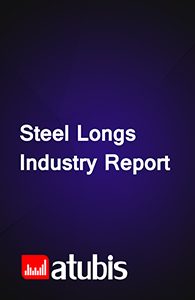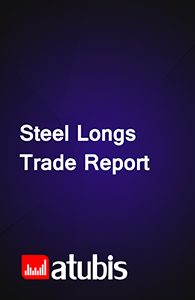Iran’s Steel Wire Market Outlook Report
9,751€
- TRY: 475,000 ₺
Steel wire is produced in different diameters based on its applications. The construction industry is the largest consumer of wire in reinforced concrete (to tie rebar) for the frames and foundations of buildings. Consumable goods such as cages, meshes, and springs with various applications are also instances of steel wire consumption. Estimates suggest that Iran’s steel wire market will have relative growth and oversupply over the coming years. On the demand side, despite higher prices in rial terms due to the depreciation of the rial against the US dollar, demand for steel wire will increase.
Product Description
With a GDP of $415 billion in 2019, Iran was the third largest economy in the region that year. While the country’s economy was steadily growing after the drop in 2012 due to the sanctions, it dipped once again in 2019 thanks to the return of the sanctions. The production of steel has increased significantly over the past years; the country was the tenth largest producer in the world in 2019.
Market drivers of Iran’s steel wire
The construction industry is the main consumer of steel wire in reinforced concrete, formwork, nets, fences, barbed wire, prefabricated walls, and ropes for elevators; the mechanical properties of steel wire have resulted in considerable demand.
Given that steel and steel products are priced based on the US dollar, higher exchange rates will translate into higher steel wire prices in Iran’s market. According to the IMF, as tensions between Iran and the West intensify, exchange rates will continue to grow; they will have tripled or quadrupled by 2024.
Overview of Iran’s steel wire market
A look at the capacities, output, and consumption of steel wire in Iran indicates that there is overcapacity in the market; companies should improve operating rates and ramp up output. Steel wire exports have mostly consisted of galvanized steel wire, while alloy steel wire constitutes the largest share of imports. Iraq, Afghanistan, and Turkmenistan are the main destinations for Iran’s exports, but imports are mostly from China, South Korea, and Taiwan. Based on estimates, supply is expected to remain greater than demand and the oversupply is expected to persist.
Breakdown of Iran’s steel wire market
Domestic demand for steel wire in the forecast timeframe as well as the previous period has been broken down using two factors. The first factor breaks down the market into five categories: carbon steel, galvanized steel, coated steel, alloy steel, and stainless steel. Past and future trends for each type of material have been analyzed. Carbon steel wire holds the largest share of the market. In the second breakdown, products are distinguished based on applications in different industries. The construction industry is the largest consumer of steel wire in Iran.
Key players in Iran’s steel wire market
- Navard Fooladkaran Ofogh
- Ayandeh Sazan Inudstrial Corporation
- Arvand Kaveh Steel
- Irof Co
- Shiraz Poolad Navard
- Vara Sanat Shargh
- Hermes Wire
- Hadid Sanat Daran
- Zanjan Wire Industry
Additional Information
| Industry | Steel Wire |
|---|---|
| Region | Iran |
| Report Type | Industry Report |
Specifications
| Report Attribute | Details |
| The base year for estimation | 2021 |
| Historical data | 2011-2020 |
| Forecast period | 2021-2026 |
| Quantitative units | Value in USD and Volume in Tonne |
| Report coverage | Market Overview, Dynamics, Market Outlook, Risks to Forecast, Consumer Market, Industry Overview, Market Landscape, Competitive Landscape, Market Attractiveness, External Macro Environment Analysis |
| Segments covered | Composition, Type, Application |
| Pricing and purchase options | Please explore our purchase options to meet your exact research needs. |
Reasons to Buy
- Recognize the geographical distribution of import demand
- Identify the current and future key players of the trading market
- Achieve a better insight on potential target markets
- Understand the behavior of major suppliers/customers either globally or regionally
- Identify competitors as a feed for market analysis
Table of Content
- Executive summary
- Introduction
- Objective
- Market under study
- Product
- Product specifications
- Consumption structure
- Applications
- Physical properties
- Subjects discussed
- Geographical scope under study
- Study timeframe
- Study currency
- Potential audience
- Market dynamics
- Market drivers
- Restraints
- Opportunities
- Challenges
- Market overview
- Market size
- Industry capacities
- Existing capacities
- Capacity distribution
- Geographical distribution of capacities
- Future capacities
- Existing capacities
- Output
- Output trends
- Operating rates
- Consumption
- Consumption trend
- Consumption Share of domestic product
- Trade
- Exports
- Imports
- Trade balance
- Market balance
- Market breakdown by product type
- Market breakdown by product type
- Market breakdown by application
- Inventory
- Producers inventory
- Consumers inventory
- Traders inventory
- Market outlook
- Market factors
- Raw materials
- Costs and prices
- Competition
- The government
- Other factors
- Future scenarios
- Risks to forecast
- Market factors
- Consumer markets
- End-user markets
- Building construction
- Infrastructure construction
- Transportation manufacturing
- Industrial equipment manufacturing
- Durable goods manufacturing
- Consumable goods manufacturing
- Direct consumer markets
- Major Direct consumers
- Existing capacities
- Drivers
- Major Direct consumers
- End-user markets
- Export potentials
- Destinations
- Trade and insurance costs
- Import market suppliers
- Producers potential share
- Destinations
- Industry overview
- Raw materials
- The supply volume of raw materials
- Supply channels of raw materials
- Raw materials procurement costs
- Cost structure of producers
- Production cost curve
- Industry value added
- Generated new scrap
- Technology
- Raw materials
- Market landscape
- Domestic sales markets
- Pricing in the domestic market
- Potential domestic demand
- Trade agreements for imports
- Foreign suppliers
- Foreign sales market
- Prices
- Potential markets overview
- Trade agreements for exports
- Foreign customers
- Domestic sales markets
- Competitive landscape
- Producers
- Company profile
- Revenue structure
- Gross profit margins
- Capacity, output and sales
- Consumers
- Company profile
- Revenue structure
- Gross profit margins
- Capacity, output and sales
- Producers
- Market attractiveness
- Industry rivalry
- Threat of new entrants
- Threat of substitutes
- Bargaining power of buyers
- Bargaining power of suppliers
- Conclusion of Porter analysis
- PESTEL analysis
- Political factors
- Economic factors
- Social factors
- Technology factors
- Environmental factors
- Legal factors
- SWOT analysis
- Large-scale companies with favorable conditions
- Short-term strategies
- Long-term strategies
- Large-scale companies with unfavorable conditions
- Short-term strategies
- Long-term strategies
- Small enterprises with favorable conditions
- Short-term strategies
- Long-term strategies
- Small enterprises with unfavorable conditions
- Short-term strategies
- Long-term strategies
- Large-scale companies with favorable conditions
List of Figures
- Output and consumption; 2011-2020
- Market share of product applications; 2020
- Market surplus; 2020-2026
- Process flowchart
- Market size; 2011-2026
- Existing capacity; 2011-2020
- Capacity distribution; 2020
- Geographic distribution of capacities; 2020
- Development of future capacity; 2011-2026
- Amount of output; 2011-2026
- Operating rates of production plants; 2011-2026
- Amount of consumption; 2011-2026
- Consumption share of domestic product; 2011-2026
- Exports of product; 2011-2020
- Imports of product; 2011-2020
- Historical trade balance; 2011-2020
- Future Market balance; 2020-2026
- Market output breakdown by alloy type; 2011-2026
- Market consumption breakdown by alloy type; 2011-2026
- Market balance breakdown by alloy type; 2011-2026
- Market output breakdown by product type; 2011-2026
- Market consumption breakdown by product type; 2011-2026
- Market balance breakdown by product type; 2011-2026
- Market consumption breakdown by application; 2011-2026
- Inventories of raw materials and products at producers factories; 2011-2020
- Consumers’ inventory of product; 2011-2020
- Traders’ inventory; 2011-2020
- Production forecast, according to raw materials and sales analysis; 2020-2026
- Market surplus; 2020-2026
- The share of end-user industries in the consumption; 2011 and 2020
- Changes in the end-consumption of extrusion products; 2020 vs 2026
- Applications in building construction industry; 2020
- Applications in infrastructure construction industry; 2020
- Applications in transportation manufacturing industry; 2020
- Applications in industrial equipment manufacturing industry; 2020
- Applications in durable goods manufacturing industry; 2020
- Applications in consumable goods manufacturing industry; 2020
- Capacity distribution structure of direct consumers; 2020
- Existing capacities of direct consumers in each province; 2020
- Suppliers of the export potential destination; 2020
- Historical exports to the export potential destination and future potential; 2016-2026
- Up-stream domestic supply; 2011-2020
- Raw materials domestic supply; 2011-2020
- Supply channels of producer plants
- Spot price of raw material in the market; 2011-2026
- Cash cost structure for production the product; 2020
- Production cost curve of the plants; 2020
- Gross value added of the industry; 2011-2020
- Generated new scrap; 2011-2020
- Sales channels
- Realized price of the product in the market; 2011-2026
- Potential demand of each province; 2020
- The main foreign suppliers to the market; 2011-2020
- FOB price vs domestic market; 2011-2026
- Map of global major importers > 20,000t; 2020
- Major foreign customers; 2011-2020
- Revenue structure of the producers; FY2020
- Sales income and gross profit margin of the producers; FY2011-2020
- Output and sales of the producers; FY2011-2020
- Revenue structure of the consumers; FY2020
- Sales income and gross profit margin of the consumers; FY2011-2020
- Output and sales of the consumers; FY2011-2020
- SWOT matrix for large-scale companies with favorable conditions
- Strategies positioning for large-scale companies with favorable conditions
- SWOT matrix for large-scale companies with unfavorable conditions
- Strategies positioning for large-scale companies with unfavorable conditions
- SWOT matrix for small enterprises with favorable conditions
- Strategies positioning for small enterprises with favorable conditions
- SWOT matrix for small enterprises with unfavorable conditions
- Strategies positioning for small enterprises with unfavorable conditions


